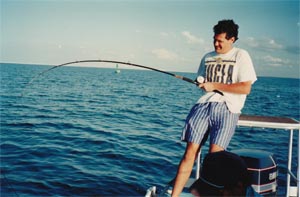Offshore Tackle: Your First Outfit
What tackle should I buy for off-shore fishing? It depends on the kind of fishing you want to do. How do you..? How do I..? Why do you do it that way..? Jeez, everybody wants to know everything. Seriously - the best advice I can give you is hire me for a day or two and I’ll show you how I do it and then you’ll know. If you can’t go that route, then go out there and try to do it on your own. After you read about it, don’t just sit there - get out and start trying, failing and learning. Every beginning fisherman does a lot of all three of these things. Don’t get discouraged, and get out there as much as possible - most people don’t catch any fish from their living room sofa or reading about it on the Internet.
 |
|---|
| Stout 8' rod with a 3/0 Penn Senator(I know what reel because it is one of my rods) |
I’ll give you some buying advice for Gulf fishing with medium to heavy tackle for snapper, kingfish, barracuda, grouper, and most other species we catch offshore in the Tampa Bay area. Keep in mind as you read this that when I was learning to fish it was Gene’s (my mentor) way or no way at all. Now you can either do this my way or your own way - but if your way doesn’t work well, don’t call me for advice.
If you have an unlimited budget, you can simply go to your favorite tackle store and tell them to outfit you for fishing in your area. I’m sure they will be able to do it for slightly under $10,000. However, if you are on a limited budget, then it only makes sense for some of your tackle to do double duty. Most of the outfits that I suggest will cost you in the neighborhood of $50.00 to $80.00 for the rod and $90.00 to $130.00 for the reel. If $130.00 to $210.00 for a setup sounds too expensive for you, then head on back to the back of the tackle shop or discount store. Buy a Zebco combination and stick to wrasslin’ bream from the lakes and ponds in your area.
A good all-round rod needs to have a good "backbone" to it. I like a seven to eight foot rod that will lift at least eight pounds of dead weight from the floor with a good arc.You can carry a five to eight pound lead weight into the store with you to try this, but be sure you ask the salesclerk first. You definitely don’t want to break a rod and have to buy it. Usually the salesperson will know what you need. Tell him or her the length, that you want to use it for grouper and barracuda and that you will be using forty pound line. OH MY GOD, FORTY POUND LINE?!?! That’s right - this article is about medium to heavy tackle, remember? If you want to know about lighter tackle, then you’ll have to wait for another article.
Now that you have chosen your rod, you will need a reel for it. We are going to use this combo for surface fishing for running fish with a light drag and for bottom fishing for grouper and snapper with a locked down drag - so you need a good reel. My recommendation is a Penn 4/0, 113H or a Penn 3/0, 112H. Both these reels have a fast retrieve that is important when a fish has a lot of line out, and they also have the guts to stand
 |
|---|
| 7' rod, with an Abu Garcia ree land 20# test line that is ideal for mangrove snapper or Spanish mackerel. |
up to locked drag bottom grinding. There are other fine reels on the market that will also work, but they are not any cheaper. Matter of fact, most of them will set you back quite a bit more.
You have your combo together and in hand -- now let the salesman wind line on your reel for you. You need "Team Fish camo" forty pound test. You can get away with thirty pound, but when bottom fishing, there is too much stretch and you will lose a lot of grouper to the lighter tests. My rigs that I use strictly for grouper are wound with eighty pound Team Fish only because the stretch is reduced enough so that I can get the grouper out of the rocks fast. Since we are building an "all-around" rod, forty pound Team Fish is what I suggest.
 |
|---|
| Another 8" rod with a 3/0 Penn Senator and 40# test line |
You also need Team Fish leader spools. Get thirty pound, fifty pound, eighty pound and one hundred pound tests in the leader spools. The "camo" line is great stuff - the combination of colors creates kind of a broken pattern that causes portions of the line to become nearly invisible underwater. It generally costs the same or less than other lines, and I think it definitely gives you an advantage.
You need hooks - 2/0, 3/0, 4/0, 5/0, 6/0, and 7/0 in a circle hook style, black swivels in size one and size seven, barrel sinkers from two ounces to seven ounces, and a roll of coffee colored stainless steel wire. Get some quality fishing pliers with a wire cutter, needle nose pliers, small sharpening stone for your hooks, small can of WD-40, small tube of reel oil, fish handling gloves, Band-Aids and ointment. Buy a box to organize and carry all of these things plus three or four times more stuff than this because by now you’re hooked. You’ll likely continue buying "stuff" for fishing as fast as you can make the money to pay for it.
The "basic" combo above with hooks, line, etc. has probably dented your pocket book to the tune of $300.00 give or take $50.00 or so. You didn’t really think this was going to be cheap did you? Believe me, this is money well-spent. Those few dollars you save by buying a cheap rod or reel will seem insignificant the first time you lose a big fish due to equipment failure.
I’ll close with a bit of advice. When you’re fishing on someone else’s boat, with someone else’s tackle, remember to treat it with care. This rule applies whether you’re paying for the trip or not. It has always amazed me when people get on my boat to go fishing and just take it for granted that since I have twelve to eighteen rods and reels on board, it’s not a big deal if one gets broken or dropped overboard. Now don’t get me wrong - broken rods are part of fishing - but not when it happens due to carelessness or lack of listening to instructions. I’ve seen folks who don’t seem bothered at all when a rig is dropped over-board after repeated warnings from the captain or mate to hold on tight to the tackle, or when a rod breaks because they rest it on the gunwale of the boat and a big fish hits. A captain who cares about his tackle will explain its proper use to you, along with some important "things not to do". Please heed these instructions, and don’t hesitate to ask questions. If your captain seems irritated or impatient with your confusion - find another captain.
Now you know the truth - fishing is a bit expensive. But now you have the basics to give it a try on your own. Watch for further articles on how to use this tackle that you have just bought.
Tight Lines,
Capt. Charlie Walker
Back to How To Index


